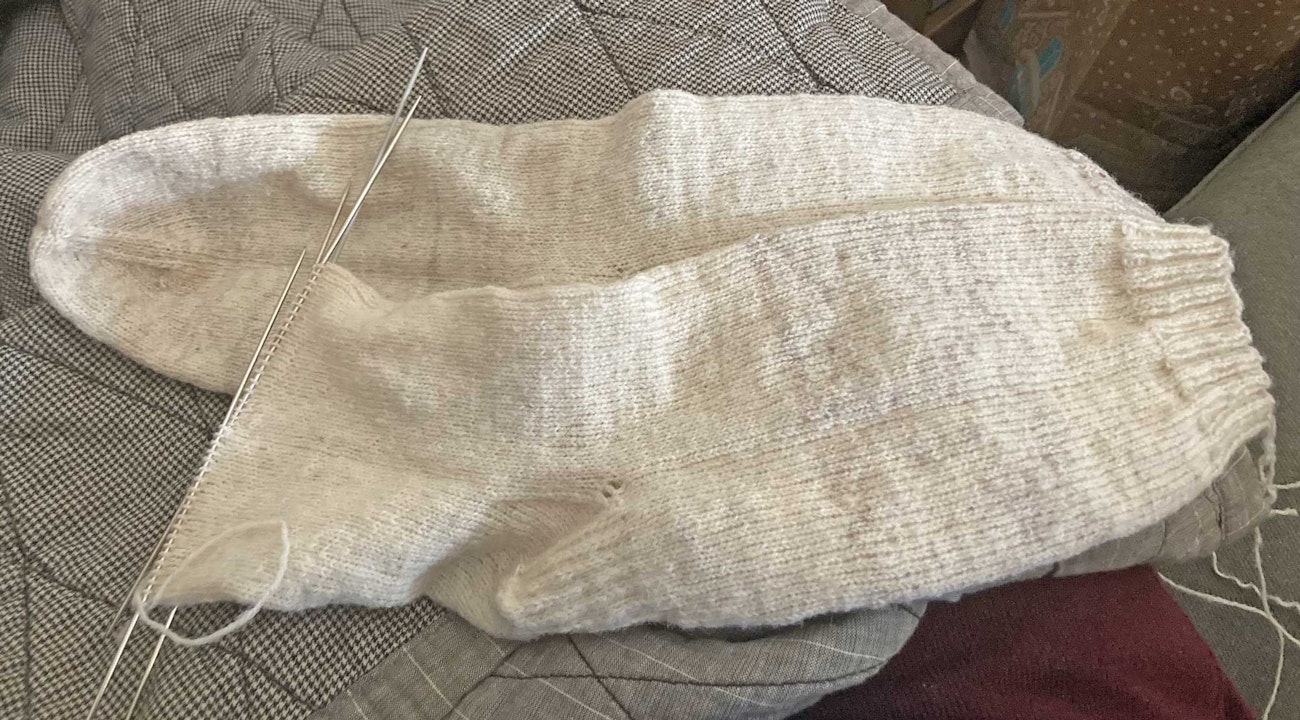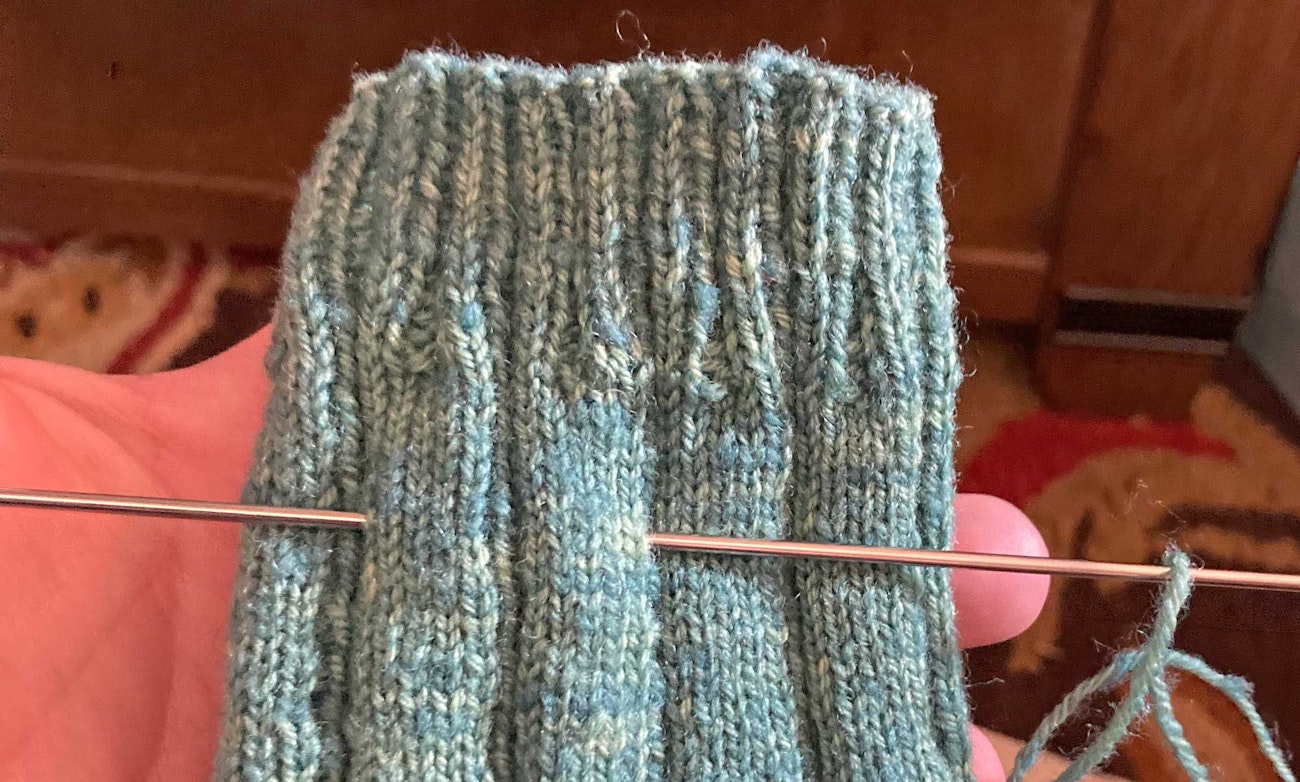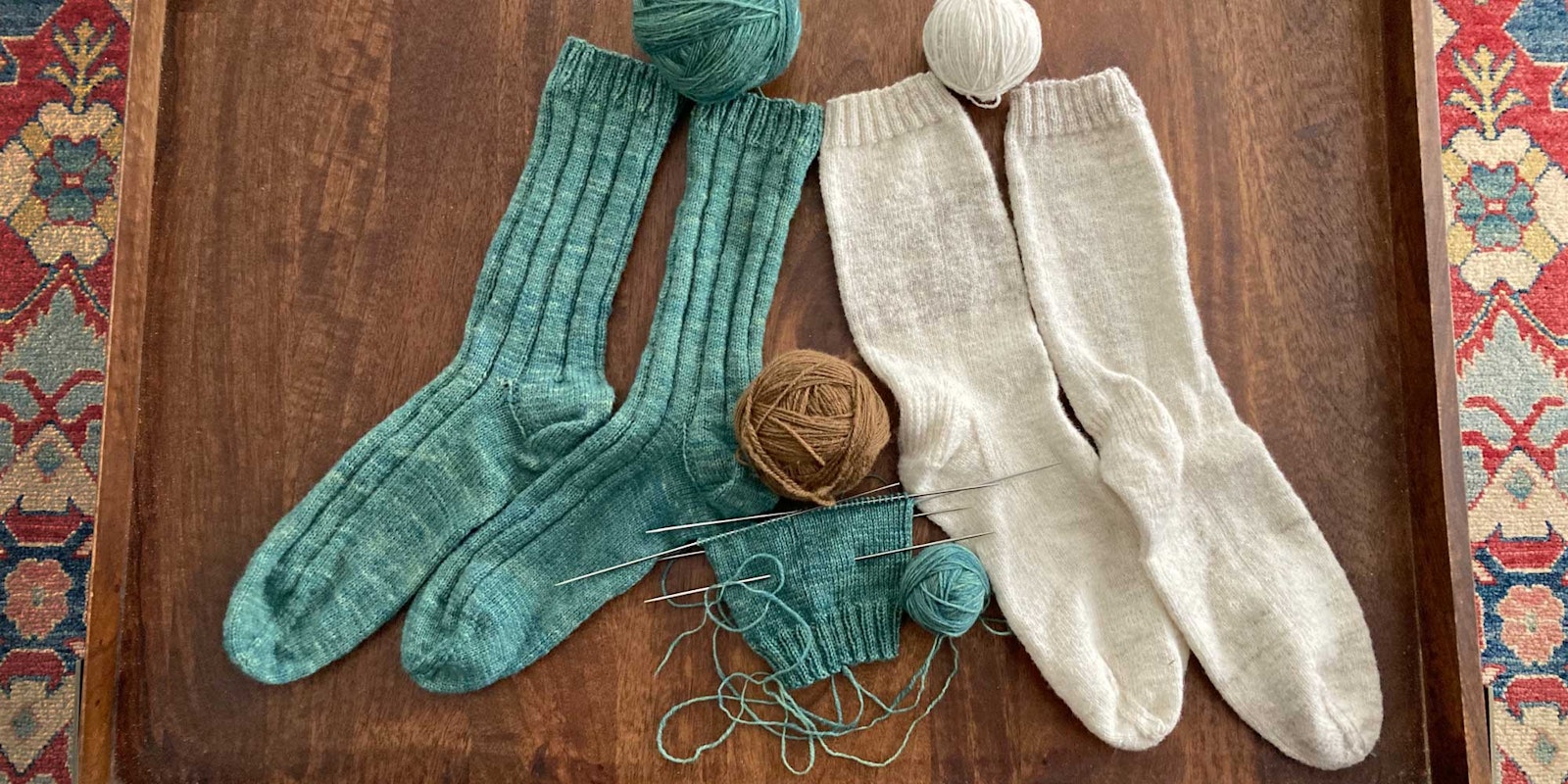Devin loves to spin Suffolk, Tunis, and Dorset fleeces—breeds sometimes dismissed as only useful for meat production. Read Devin’s post about these “meat sheep” and then learn Devin’s strategies for spinning high VM fleeces such as these, which tend to have more vegetable matter than fleeces raised with handspinners in mind. Here, Devin shares the end result: not one, but two fantastic pairs of knitted socks made from Suffolk and Tunis fleeces! –Editors
Last fall I wore out the last pair of handspun socks in my sock drawer. I have plenty of handknitted socks made from commercial sock yarns, but I prefer to wear handspun wool. And it shows in the wear patterns; my commercial socks will sit in the drawer as I grab the handspun socks time and again. My socks tend to wear out across the entire sole at once. When I have a hole in the toe or heel I darn it. But although I reinforce the soles of my socks by “running” them (sewing a reinforcing yarn lengthwise across the sole, threading it through the purl bumps), when they get thin they often blow out all at once. I usually set these aside until I can reknit the feet by cutting the sock off right above the heel and reknitting it using the same or alternating yarn. I have several pairs set aside to be fixed this way, yet I prefer to knit a new pair of socks because it’s my ideal travel, television-watching, vanilla-sort of knitting project to have on the needles.
At the beginning of 2023, I decided to knit some new handspun socks for myself. I have been trying to spin down my fiber stash and had spun some Suffolk and Tunis fleece into 3-ply yarns in a gauge that would work well for socks. I personally knit both 2-ply and 3-ply yarns into socks, and don’t see a difference in how the yarns wear—to me, what makes a difference is gauge. The socks I knit to a tight gauge, using a smaller needle than typically recommended for the yarn grist, tend to wear the best and feel the best with less noticeable purl bumps on the sole of the feet.
I knitted my new socks using US#1 (2.25 mm) needles and using the same sock pattern I always use—one taught to me by my Tante Fanni. I always use the same pattern, incorporating variations here and there, sometimes knitting the calf in ribbing, sometimes using a slightly different heel, all depending on my whim at the time. But these socks fit my wide feet and ankles well.
 Devin spun up unndyed Suffolk fleece for this pair of socks.
Devin spun up unndyed Suffolk fleece for this pair of socks.
The Suffolk socks are undyed and knitted in plain stockinette stitch. This fleece had a few small dark strands, and when carded and spun up, the yarn had a beautiful, but subtle, natural variation that I wanted to embrace by featuring it prominently in the pattern. The Tunis socks are knitted from yarn dyed in wolf lichen and then dipped in an indigo vat. The yarn still has the faint scent of wolf lichen, which to me, smells like a forest and is one of my favorite scents. It lingers for a long time in fiber that’s been dyed with it, lasting through washing and use. I knit this particular pair with a ribbing in the calf and top of the foot just for a variation. Both of these breeds of sheep produce fleece that wear well and will make sturdy socks that stand up to hard use.
 The Tunis socks feature a ribbed calf.
The Tunis socks feature a ribbed calf.
There is enough of the green Tunis yarn left for me to knit another pair of socks if I use some of the same Tunis yarn I dyed with walnut for the heels and toes. I have already begun to knit this pair and they sit in my knitting bag next to my seat on the couch for me to pick up and knit while I relax and watch TV in the evenings. Having 3 pairs is a good start on replenishing my handspun sock stash, but I want to knit at least 2 more pairs before next winter. Five pairs of handspun socks is the minimum amount I prefer to have in my wardrobe. One of the many reasons I love using handspun wool for socks is that I can wear the socks for 2 or 3 days at a time before putting them in the laundry. As long as the snow and mud of a Minnesota winter don’t get inside my shoes, the socks remain clean and do not smell for several wears, keeping my feet both dry and warm.
Handspun socks are a fantastic way to incorporate handspun, handmade items into your wardrobe, and I encourage spinning knitters to experiment with sock yarns.
Find Devin’s go-to sock pattern in Spin Off Winter 2018, “Spindle Spun Socks.” The design was taught to them by Tante Fanni (Devin’s great-aunt Fanni) during a stay with family in Germany. If you are an active subscriber to Spin Off magazine, you have unlimited access to previous issues, including Winter 2018. See our help center for the step-by-step process on how to access them.
Devin Helmen has been immersed in fiber since learning to spin at age eight. They spin, knit, and weave in beautiful Minnesota. Devin enjoys writing and teaching about fiber arts and has a passion for spindles and everyday textiles. They blog, intermittently, at afewgreenfigs.blogspot.com.

